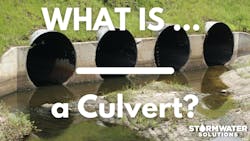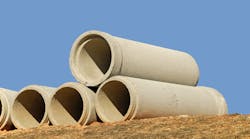A culvert is a short tunnel structure that primarily conveys water beneath an obstruction.
Culverts are an essential part of stormwater drainage systems. They are particularly important for the effective management of surface runoff across roads and highways.
What is the purpose of a culvert?
In the context of stormwater management, culverts help to convey water from one side of an obstruction to the other. This serves important hydraulic functions, ensuring that surface runoff flows properly.
A common function of a culvert is to convey surface runoff across the embankments that support raised roads.
One benefit of allowing surface runoff to travel below an obstruction is that the water will not travel around or over the obstruction. If the obstruction is a road, diverting runoff over the road will lead to flooding, sediment deposition, and unsafe driving conditions. Diverting runoff around the road will lead to flooded ditches, sediment deposition and a continued risk of road flooding.
Culverts also sometimes provide essential structural functions, depending on the type of culvert and surrounding environment. From the perspective of a transportation official, a specific box culvert may be primarily useful for conveying traffic over a waterway. For example, the difference between some culverts and bridges can be a matter of length: a culvert will generally have a span of less than 20 feet.
What are the types of culverts?
A culvert’s characteristics can differ depending upon local conditions and needs.
The installation type will generally vary between two to three main methods. Culverts can also be constructed in a wide variety of shapes and out of a variety of materials.
Culvert installation types
Culverts are generally either trenched or placed in an embankment. They can also sometimes be bored/augured/jacked.
- Trenched culverts are placed in a narrow excavation on a prepared bedding, and then covered with earth backfill.
- Embankment culverts are often bedded in natural ground, overlaid by a constructed embankment.
- In embankment installations, there are three ways that a culvert barrel can be installed:
- a positive projection barrel is installed with the top of the barrel above the natural ground;
- a negative projection barrel is installed in a shallow trench, where the top of the barrel is below the natural ground and then covered with earth;
- induced trench barrel is installed with the top of the barrel above natural ground, similar to a positive projection barrel, but with a unique material above it: once the earth fill is placed well over the barrel, a trench is excavated over the barrel to fill with a more compressible material.
- Each of these embankment installation types are still located below the top of the embankment.
- Bored, augured or jacked culverts are installed when the conventional methods are not practical, such as when a deep installation is necessary. This is an expensive installation method that digs out a tunnel and installs the barrel without needing an extensive trench across the length of the culvert.
Effective management of the bedding and backfill is essential to ensure that the culvert performs structurally and maintains a long service life. The material, shape and installation type of a culvert will decide how the surrounding soils ought to be managed to distribute loads properly.
Culvert barrel shapes
The basic categories of culvert barrels’ shapes are circular, elliptical, arch and box.
- Circular culverts are one of the most common shapes. The cross-section of a circular culvert barrel is a full circle. This is a structurally efficient shape but also means that low flows limit the available width of a stream passing through the culvert.
- Elliptical culvert shapes are often preferred over circular culverts when a high width is desirable during low flows. This comes at the cost of a less efficient structure. The cross-section of an elliptical barrel looks like an oval.
- Arch culverts feature the curved top of a circular or elliptical culvert but without any barrel material on the bottom. This is feasible where the material at the bottom of the culvert’s stream is naturally resistant to erosion and abrasion.
- Box culvert barrels have a cross-section in the shape of a rectangle or square. They are not as structurally or hydraulically efficient as the curved shapes, but are often more adaptable to varying site and culvert size requirements.
Each of these barrel shapes can also have a varying number of barrels for more or less flow capacity. These can increase hydraulic capacity of a culvert, but can increase risks of clogging and excessive sedimentation.
Culvert barrel materials
The most common culvert barrel materials are concrete, metal and high-density polyethylene (HDPE).
The culvert barrel can have a structure surrounding it made of a different material. A culvert may only be a corrugated steel pipe within an embankment, or it could be a large concrete structure with rip rap on the bottom. Box-shaped culverts, for example, are generally a significant concrete or steel structure, while circular culverts can often just be a pipe surrounded by soil.
Each culvert barrel material may also use a unique coating. The choice of coating can depend on local soil and runoff chemistry, local temperatures, solid material being carried through the culvert, and more.
- Concrete is a more expensive barrel material but is also stronger. Concrete can bear heavy loads, is resistant to corrosion, and provides a long service life. Concrete culverts are generally not coated but may use an epoxy resin or special concrete material for harsh chemical environments.
- Metal barrels in culverts are often either galvanized steel or aluminum. They are generally corrugated to convey runoff. They are strong and durable but can be susceptible to corrosion and blockages. Metal culverts can utilize a wide range of coatings depending upon the local environment, including zinc alloy coatings, polymers, concrete, mortar or aluminum.
- Plastics are often affordable and have a long service life. However, they are sensitive to heavy loads, excessive heat and certain chemicals. Plastics can generally be high-density polyethylene (HDPE), polyvinyl chlorine (PVC) or fiber reinforced plastic (FRP).
While these materials are the most often used, culvert barrel materials are not just limited to them. Culverts can also be composed of masonry such as stone or brick, wood, vitrified mineral aggregates, cast iron and more.
Conclusion
Culverts serve an important hydraulic function in conveying water beneath an obstruction. They are popular for conveying surface runoff beneath the embankments of roads and highways.
Culverts can also come in a wide variety of installation types, barrel shapes, and materials. Each choice among a culvert’s variables are decided by the installation’s particular needs and environmental conditions.
References
Craig Ballinger and Patricia Drake. “Culvert Repair Practices Manual, Volume 1.” U.S. Department of Transportation Federal Highway Administration. May 1995. https://rosap.ntl.bts.gov/view/dot/58545. Accessed Feb. 6, 2024.
North Carolina Department of Transportation Hydraulics Unit. “Culvert Identification Field Guide.” January 2021. https://connect.ncdot.gov/resources/hydro/Hydraulics%20Memos%20Guidelines/Culvert_Identification_Field_Guide.pdf. Accessed Feb. 6, 2024.
Jeremy Wolfe | Editor, Stormwater Solutions
Jeremy Wolfe is a former Editor for Stormwater Solutions.











